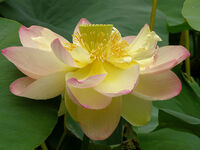| This article is missing citations or needs footnotes. Please help add inline citations to guard against copyright violations and factual inaccuracies. (June 2008) |

First page of the Lankavatara Sutra
Mahāyāna Buddhism | |
|---|---|
| Lands | |
|
India • China • Japan | |
| Doctrine | |
|
Bodhisattva • Upāya | |
| Mahāyāna Sūtras | |
|
Prajñāpāramitā Sūtras | |
| Mahāyāna Schools | |
|
Mādhyamaka | |
| History | |
|
Silk Road • Nāgārjuna |
The Laṅkāvatāra Sūtra (Chinese: 楞伽經) is a sutra of Mahayana Buddhism. According to tradition, these are the actual words of the Buddha as he entered Lanka and conversed with a bodhisattva named Mahamati. This sutra figured prominently in the development of Chinese, Tibetan and Japanese Buddhism. The Lankavatara Sutra is the cornerstone of Chinese Chán and its Japanese version, Zen, and was translated from Sanskrit into Japanese and English by the lauded exponent of Zen, Daisetz Teitaro Suzuki.
Doctrine[]
The most important doctrine issuing from the Lanka is that of the primacy of consciousness, often called simply "Mind Only", meaning that consciousness is the only reality. The sutra asserts that all the objects of the world, and the names and forms of experience, are merely manifestations of the mind. It is the erroneous concept of subject/object that ties us to the wheel of rebirth.
The Lankavatara Sutra represents a syncretism between Tathagatagarbha thought and the Yogacara school.[1]
Store consciousness[]
The Lankavatara Sutra describes the tier of consciousness in the individual, culminating in a "store house" consciousness (alaya-vijnana), which is the base of the individual's deepest awareness and his tie to the cosmic. This tier of consciousness is divided into eight faculties:
- The eye sense
- The ear sense
- The tongue sense
- The nose sense
- The body sense
- The Sense Center (mano-vijnana)--Apprehends psychic events and synthesizes experiences.
- The individualizing center of egotism (manas)--This is the deeply seated consciousness in the person which ignorantly clings to the ego-conception of reality of an external world. It is the center where all selfish ideas, egotistic opinions, arrogance, self-love, and illusions are fermented and is the source of all delusion.
- The storing center of ideation (alaya-vijnana). Tibetan Buddhism refers to it as the "consciousness which is the substratum of all". It is a kind of eternal repository from which can be drawn the substance of every possible image and idea (similar to Jung's concept of the collective unconscious, only with more explicit spiritual implications).
Trikaya[]
The Lanka also suggests another important Mahayana doctrine, developed in later Buddhism, and that is the three bodies of Buddhahood, in effect the three levels of enlightened reality:
- Terrestrial or transformational dimension, ( = Sanskrit nirmanakaya) - The dimension of Buddhahood to which the unenlightened have access, and where the phenomena of the world exist.
- Celestial dimension, (= Sanskrit sambhogakaya) - expression of the symbolic and archetypal dimension of Buddhahood, to which only the spiritually developed have access
- Transcendental dimension ( = Sanskrit dharmakaya) - the ultimate level of enlightenment, which is beyond names and forms
Notes[]
- ↑ Youru Wang, Linguistic Strategies in Daoist Zhuangzi and Chan Buddhism: The Other Way of Speaking. Routledge, 2003, page 58.
References[]
- Online version of full text of the Sutra translated and introduced by D. T. Suzuki (710K)
- Lankavatara Sutra, translated into English from the Sanskrit by D.T. Suzuki. Boulder, CO: Prajña Press, 1978, ISBN 0-87773-702-9, first published Routledge Kegan Paul, 1932.
- Studies in the Lankavatara Sutra, by D. T. Suzuki
- The Lankavatara Sutra : An Epitomized Version, (Provenance Editions) by D.T. Suzuki
- The Lankavatara Sutra BIONA online version at the Buddhist Information of North America website.
- Version française du Lankavatara Sutra version of the Suzuki/Goddard translation of the Lankavatara Sutra
- Collection of materials for studying the Lankavatara sutra. (Page text is in Russian but materials are in English, Sanskrit, Chinese, Tibetan.)
ru:Ланкаватара сутра tr:Lankavatara Sutra vi:Nhập Lăng-già kinh zh:楞伽經
